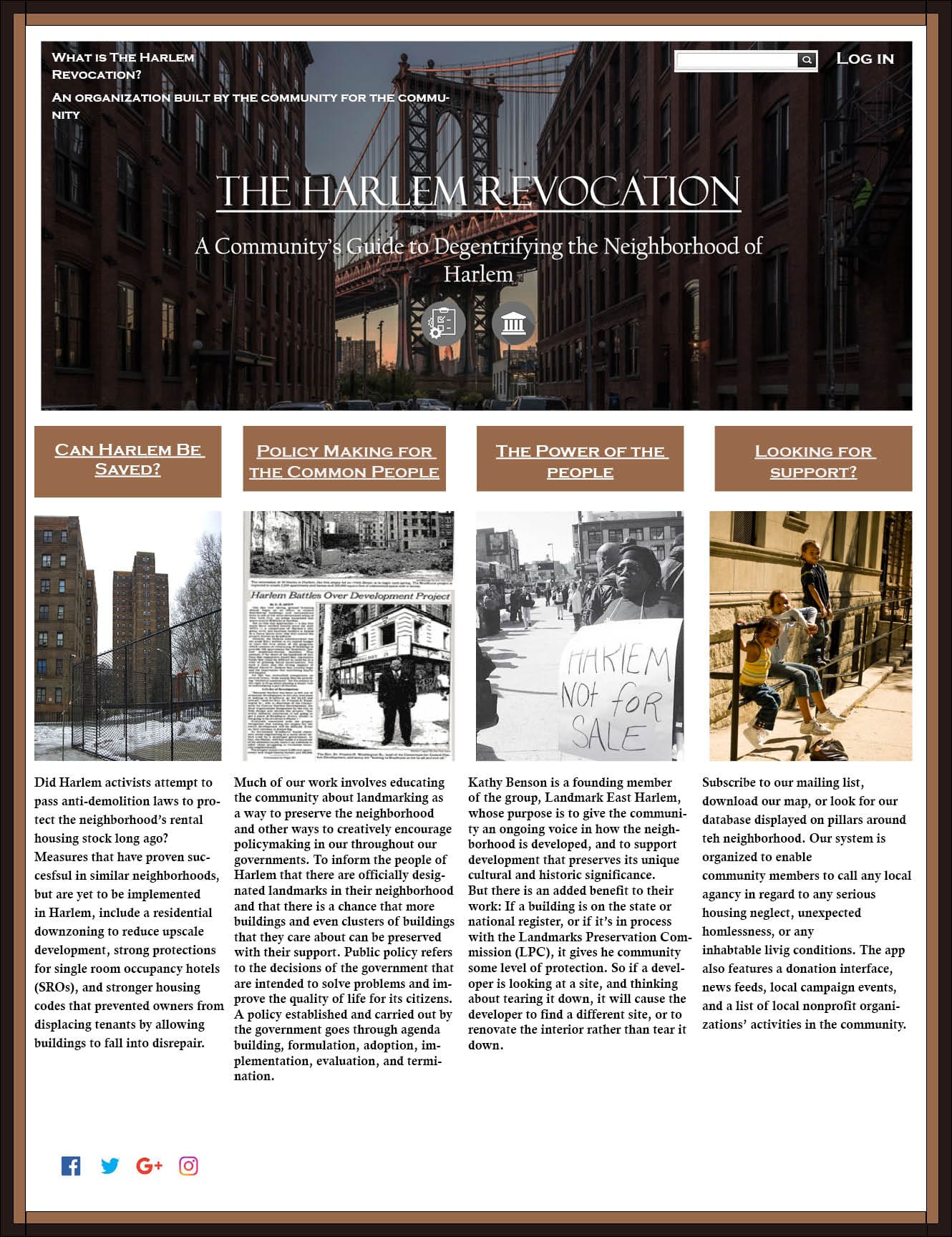The Harlem Revocation
A wicked problem that greatly affects the living conditions, cultural record, and environmental health of a historical community, such as Harlem, New York, is gentrification and the resulting homelessness. Gentrification in communities are forced upon locals without any plans to accommodate those who cannot adapt well, causing homelessness and low health standards of those who must endure public housing. Our group decided to choose gentrification in Harlem because, it is a critical complex issue that has infiltrated many landmark urban societies across America, with its corrupted social, cultural, and socio-economic hierarchy. As university students, it is very likely in the near future, some of us will integrate in the city and choose to live off campus and thus, contribute to the influx of foreign takeover of local neighborhoods. Gentrification often results in the increase of the homeless population due to the sporadic increase in rents of a tenant. In addition, the community experiences a severe lack of available public housing units to accommodate those homeless individuals. This wicked problem is relevant not only due to its ties to people’s well-being, but also because it puts the spotlight on government policies. Our goal is mitigate the strategic and unnecessary destruction of buildings that affect the quality of the surrounding environment and the population of homeless locals, while preserving the historical value of the district of Harlem.
The local people of Harlem, those that have lived in the community for generations and are being pressure to migrate out to make room for the middle and upper class, are who will be supported by the work of The Harlem Revocation. These are the same people who have stated that “the rents went up, the whites and tour buses started to come, and black people started to leave, relocating to New Jersey, Connecticut, the Bronx, even “down South,” in search of affordable housing. Many friends and family left. The shops began to close, and houses that were once $300,000 now easily go for well over $1 million. Studios that were once $500 are now $1,800 if you’re lucky.” By exercising the efficient communication and education of the community, which government officials tend to filter for political purposes, our website and its network throughout the city and mobile devices will garner local groups to realize what is actually happening in the community and use their power as constituents to combat gentrification.
Inspired by the online nonprofit online platform, DoSomething.org, this system, The Harlem Revocation, uses education and charitable incentive to garner community involvement of social and political issues. The use of technology through the internet, mobile apps, and the interactive poles that are already spread throughout the city is an effective tool to expand awareness- creates political agenda much clearer to the public, fundraising – increase contributions to fund the services that will give back to the community, messaging – easily accessible to everyone (even those on the streets without mobile devices), engagement – increases supporter’s motivation and involvement, media – increases positive media engagement and coverage, educate – teach the community on issues, events, government goals and what they mean to them, and surveys – to find out what issues are important to constituents and what areas are most critical. In addition, apart from the technical view, there are a few non-technical aspects as well to improve the effectiveness and receival of the system: the public can use the app to ask questions from representatives of the local government or nonprofit organizations that deal with public housing and tenant issues, offer relevant news in the form of articles, push notifications that alert the user of voting terms or the announcement of new policy actions, and a live chat section, within the app, brings the public closer to their representatives and understand each other in a much better way. A similar system of political mobile app technology was successfully used by the Obama administration in the year 2008. Also, this technology is meant to connect the community directly to government representatives, who seem unreachable for the most part because, if they don’t have the capacity to write policy themselves or gather feedback from constituents, Congress members end up making policy that is essentially created by corporate lobbyists. This platform gives Harlem residents the tools they need to know and communicate the necessity of measures that include a residential downzoning to reduce upscale development, strong protections for single room occupancy hotels, stronger housing codes that prevent owners from displacing tenants by allowing buildings to fall into disrepair, the development of private/nonprofit housing ownership rather than public/city housing.

